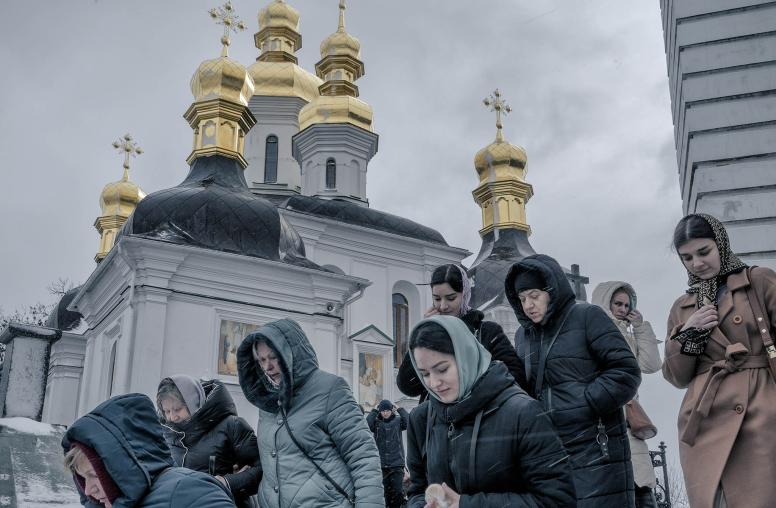Diplomacy May Not Be As Dead As It Seems
Protraction in Ukraine suggests that force is at present an ineffective tool for achieving political aims.
The Ukraine war has revealed changes in warfare that may give renewed purpose and utility to diplomacy as an instrument of statecraft in the modern era.

At first this may seem like a surprising claim, given that there is no diplomatic end in sight to the war itself. In the nearly two years that have passed since Russia invaded Ukraine, the fighting has devolved into World War-One style combat in which perhaps as many as half a million people have perished. In this fight to the death, diplomacy hasn’t had much of a role. It’s not just that no peace process is underway; it’s that it’s hard to even imagine a meaningful and durable diplomatic resolution to the war. While Ukraine has used diplomacy to build international support for its position, its leaders have so far judged, probably correctly, that any attempt to negotiate would probably be used by Russian President Vladimir Putin to buy time, rearm and resume the conflict later.
Rethinking Diplomacy
Looking at this state of affairs, a reasonable observer could conclude that traditional diplomacy, defined as the use of negotiations to reconcile conflicting interests, is one of the war’s most conspicuous casualties. It’s not just AWOL, it appears to be dead entirely.
But take a step back, and a different picture comes into view. The Ukraine war has revealed some unexpected things about the nature of modern warfare that could profoundly reshape how states think about, and practice, diplomacy. The very attributes that make the war so terrible—its brutality, intractability and immense expense in lives and treasure—may also, paradoxically, lead states to attach renewed importance to diplomacy in the years ahead.
For starters, the fighting in Ukraine suggests that military force is not at present a terribly effective instrument for achieving political outcomes. As the 19th century Prussian strategist Carl von Clausewitz famously observed, the ability to deliver such outcomes lies at the very heart of war’s purpose. When states can achieve their ends through decisive force at a reasonable and tolerable cost, they are likely to favor war as an instrument of policy; when they cannot, they are more likely to consider other means to achieve their ends.
Going into Ukraine, Russia’s leaders—and even some senior U.S. officials—appear to have believed that the war would be short, sharp and decisive in Russia’s favor. But that hasn’t been the case. Despite possessing superior numbers, firepower and a significantly larger population and industrial base, Russia has so far been unable to impose its will on Ukraine. While it’s too early to draw sweeping conclusions, it certainly seems that the defensive has the upper hand on the modern battlefield. This may have to do partly with Ukraine’s geography, which complicates widescale offensives. But as a number of military analysts have observed, it may also have to do with the nature of current military technologies, which by easing the identification and targeting of attackers, tend to penalize movement on the modern battlefield.
The Offense-Defense Balance
The offense-defense balance has important implications for the future of diplomacy because the utility of the diplomatic instrument tends to be closely tied to the state of military technology. Political scientists have long observed the positive correlation between the primacy of the offensive and the likelihood of conflict; as MIT political scientist Stephen Van Evera put it memorably, “war is more likely when conquest is easy.” A less observed corollary is that diplomacy tends to have the most space to produce results in periods when the defensive dominates (and warfare tends toward stalemate), for the obvious reason that force is not easily converted to political ends. That may be where we are today. The course of the war to date suggests that countries inclined to attack their neighbors will, as a matter of prudence, have to think at least as hard about how they plan to end and exit a conflict as they do about how to start one.
Second, and relatedly, the war’s progress to date casts doubt on the potential of nuclear weapons to help aggressors out of this predicament. Despite possessing the largest destructive arsenal in the world and famously devising strategies of nuclear escalation to win a war, Russia has so far failed to translate its status as a nuclear power into an advantage in the war. So far, Russia’s leaders have not found a convincing strategic benefit to utilizing a nuclear weapon against either a civilian or military target in Ukraine. And considering that the Russian state appears to be straining every other nerve to win the war, that’s saying a lot.
Even if Russia decides to use a nuclear weapon in Ukraine, it’s not clear that doing so would change Ukraine’s will to resist. In this sense, the war supports the longstanding contention that nuclear weapons are poor instruments for coercion. In the late U.S. economist and Nobel laureate Thomas Schelling’s famous formulation, they lend themselves much more readily to deterrence than to compellence, or using threats of force to coerce an opponent to change its behavior. Possessing nuclear weapons doesn’t necessarily make their owner more likely to succeed in convincing a victim to surrender its sovereignty, or for that matter, stop a friendly onlooker from helping the victim. If aggressors can’t easily achieve their objectives by conventional force, and nuclear weapons don’t provide much help in breaking through the resulting stalemate, then eventually they are likely to look to other means to achieve their ends.
The Limits of Military Force
None of this is fixed in stone, of course. War is fluid. Technology changes constantly and the present conflict is far from over. Even if force doesn’t yield results soon, Russia is unlikely to abandon its aims. Nevertheless, at least as things stand at present, what the war demonstrates about the power of the defensive is broadly positive from the perspective of those countries that favor preservation of the international status quo, and negative for those that would be likely to revise the system in their favor and might be tempted to use force to do so.
The job of U.S. diplomacy should be to reinforce this effect. Simply put, it should be to array power and legitimacy on the side of the defender not just in Ukraine but in other regions where small states find themselves the objects of machinations by larger powers.
Both power and legitimacy are essential components of international order. The first is the most consequential. To array power behind the defender is not just about providing U.S. arms, it’s also about building and maintaining coalitions of states that share those countries’ desire to preserve the status quo. The hardiness of Ukraine’s resistance eases the burden of persuasion with those onlookers by showing that self-defense by a military underdog has a reasonable prospect of success in defying a larger aggressor. If it were otherwise, and the offensive were in the ascendancy, then U.S. diplomacy would have a much steeper hill to climb in convincing threatened states to resist when the odds of survival were dim.
The second component—legitimacy—is almost as important. The late Henry Kissinger called legitimacy “an acceptance of the framework of international order by all major powers.” That definition sets an impossibly high bar in the current setting, where one authoritarian revisionist power is attempting to alter international order by force and others may be tempted to do so. It’s important to remember that the challenge they pose is, first and foremost, a territorial one; if they can succeed in altering the map of their neighborhoods, revisionists may reasonably calculate they stand a good chance of drawing the United States into a reformulation of the overarching framework of international order on terms more favorable to themselves.
Attempting to find a shared concept of legitimacy with revisionist rivals through diplomacy is probably not a viable path at a moment of dramatic instability and ongoing shifts in the military balance. A better approach is to use diplomacy to reinforce the legitimacy of the existing order as exemplified by the territorial viability of its most threatened outposts.
Here too, the ascendancy of the defense on the battlefield makes the diplomat’s job easier. Protraction provides a prolonged showcase of the brutality that underlies the aggressor’s conception of order and an enlarged window for organizing a political defense of the status quo. Supporting threatened states by forming coalitions that provide them succor and enlisting international law to highlight the justness of their self-defense helps to ensure that the burden of escalation is as heavy as possible for aggressors not just in military terms but morally and politically as well.
This suggests that diplomacy’s greatest potential, contrary to recent obituaries, lies precisely in the preservation of sovereignty and territorial integrity that has been its main vocation since the 1648 Treaty of Westphalia. Indeed, in the Western tradition, diplomacy has long been an inherently defensive tool, used to preserve the status quo against conquest. Diplomacy in the service of revisionist aims is not really diplomacy but warfare by other means; as the British scholar Martin Wright has pointed out, authoritarian regimes have a tendency to “abolish diplomacy altogether” and “[pervert]… the threefold function of diplomacy: espionage in place of information, subversion in place of negotiation, propaganda in place of communication.”
War and Diplomacy: Two Sides of the Same Coin
The point in all of this is not to argue that diplomacy will bring about an end to the Ukraine war anytime soon. Indeed, a premature attempt at a negotiated settlement in Ukraine could undercut the goal of strengthening the defensive by showing that a couple of years of sacrifice can give aggressors want they want. Rather, the point is that diplomacy and force are intimately linked. Americans, in particular, have a tendency to forget that fact; as the Cold War diplomat Robert Strausz-Hupé observed, our propensity as a nation is to view peace and conflict as inherently opposed and separate realms in the conviction that peace arrives through the application of reason “when the guns fall silent.” In fact, war and diplomacy are two sides of the same coin. Changes in warfare—which is to say changes in the utility of force as an instrument for achieving political objectives—have profound and far-reaching implications for the use of diplomacy.
All of this matters for reasons that go beyond theory. Proxy wars have a way of producing a demonstration effect that influences the character of subsequent events. To cite one prominent example, the Spanish Civil War in the 1930s unveiled new technologies, in the form of improved tanks and bombers, that favored the offensive and thereby encouraged revisionist powers to try to use these weapons to conquer neighbors. By contrast, if things continue on their present course, the Ukraine war could have the opposite effect. By showcasing the difficulties and costs of offensive warfare, it could produce a chilling effect on would-be aggressors. The job of U.S. policy, in all of its forms, should be to reinforce that effect in ways that discourage aggression.



